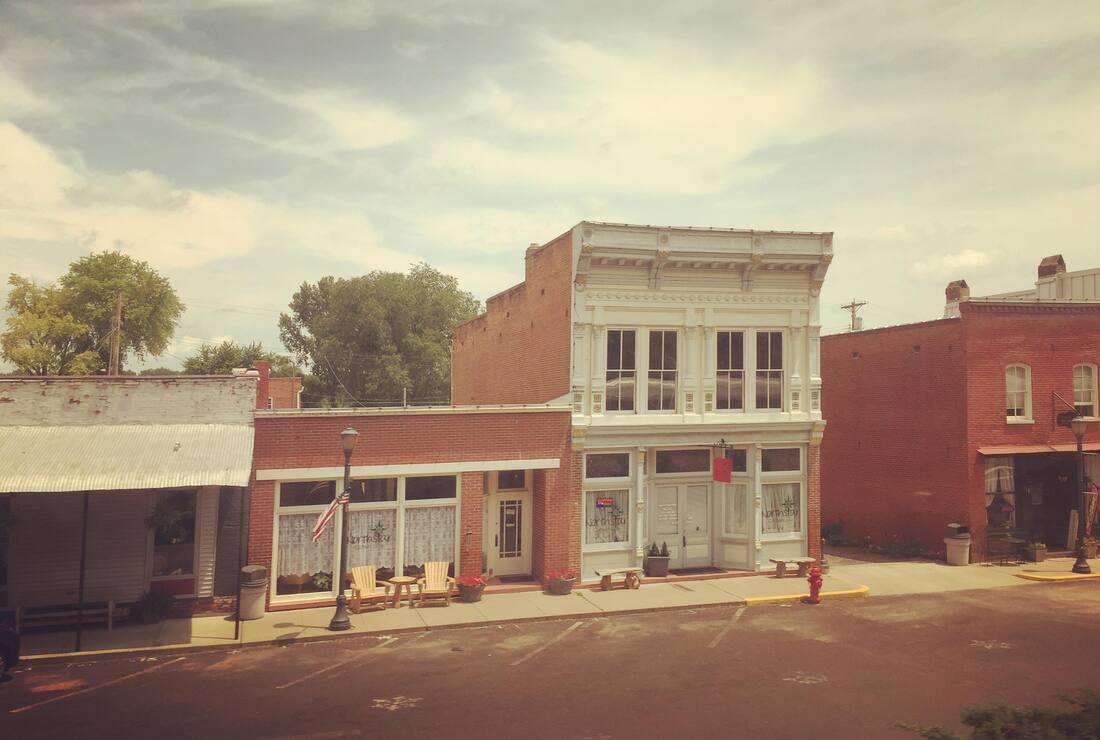|
I started writing Will and Julia's story 13 years ago in Charleston, South Carolina! But New Milford, the setting of Butterfly Weeds, was inspired by the town in Missouri pictured below. It's the same small town where I spent my adolescence. If you haven't had a chance to read Butterfly Weeds or its sequel, My Butterfly, you can find them on Amazon! Happy reading! ♥ Laura “You’ll get in, and I’ll be happy for you. And we’ll find a way to be together--no matter what. If I have to sing songs on the sidewalks of New Milford to get to you, I’ll do it." -Will Stephens
0 Comments
My grandparents are no longer on this side of eternity, but I was fortunate enough to know one of my grandpas for much of my life. He was quiet; a farmer; a World War II veteran; and he almost exclusively wore overalls and an old, leather cap. And today, all the grandpas that I write into my novels and poems have a likeness to him. This poem, found in Love Story, is no exception. You can find Love Story on Amazon.
 Today is my mom and dad’s 36th wedding anniversary! My mom moved from South City St. Louis to Berger, Mo. in 1980. At the time, Dad farmed the land around the house she would buy. The story goes that it didn’t take too long before Dad “started showing up,” asking Mom questions about her horses. So, one day, nearly 40 years ago, she asked if he wanted to go for a ride. Happy Anniversary, Mom and Dad! #thebeginning #citygirl #countryboy  I love letters! My grandma saved the letters Grandpa wrote to her. One from 1950 says: “I hope we’re together this time next year ‘cause I love you so much, and I just keep thinking of you all the time.” They married nearly two years later and were together for 54 years. Every letter talks about “waiting on Sunday.” That’s the day Grandpa would meet Grandma at her parents’ home for supper. In another letter, Grandpa talks about how “awful bashful” he was when meeting Grandma’s parents for the first time. ☺️❤️ P.S. This is the same grandpa that inspired River's grandpa in By Way of Accident!  I remember the trailers—so many cattle trailers—from neighbors who knew we had animals that needed to get out before the waters came in. I remember drinking the canned water from Anheuser-Busch. I remember the Amish and Mennonite men and women (whom we had never met) who traveled from across the country to clean six inches of river silt from our home. I remember the same Amish and Mennonite men and women who stayed through the winter to build our new home. I remember the generosity from people in the community. I remember the gifts that Christmas from the Salvation Army. I remember the woman from a little town in Massachusetts (who had never met me) who sent me encouraging letters for nearly 20 years after the flood. My parents had to find a new normal for their family. And some days were hard, especially for them. But today, I am thankful because in 1993, when we lost “everything,” God showed us humanity. So, if you can, please help those in Texas—in any way you can. It matters. I know. Because it's been 24 years, and it still matters. #Hurricaneharvey  Fifteen, short years ago, this was just a dream. Everything. The track. The hurdles with Shamrocks painted on them. The pole vault pit. The jump mats. The cage for the discus. The volunteers. The dozen busses in the parking lot. Just fifteen, short years ago, I asked my high school principal when WE were going to get a track. His response: When YOU pay for it. Well, how much is it? I asked. About a quarter of a million, he said. And that was the end of that conversation. Well, thankfully, I didn’t have to foot that bill. Thankfully, the community came together and did that—in just a few years! And yesterday, New Haven hosted its first EVER track meet. Had I just left New Haven two days earlier? Yes. Did I think twice about driving all the way back across the state again—for one day? No. I had to be there. I had to be there because this was always just a dream to me; I had to see it in real life. And just to put this a little more into perspective, my nephew and I had a conversation while walking on the old "track" that went something like this: Me: "Aunt Wawa, Aunt April and Mommy used to run on this track." Jack: "What track?" Me: "This one—the one we're standing on." Jack: "This isn't a track." Me: *nods head "Yes, Jack, you are correct." So, yeah, yesterday was pretty cool. Everything ran smoothly, there were tons of volunteers, athletes ran fast and jumped and threw far and New Haven won the meet. You never would have guessed that this was New Haven’s first—like, not even a practice meet—track meet. To say I was a little proud to be an alumna is like saying I'm a little in love with the Great British Baking Show! So, yes, yesterday, I wore that three-leafed plant as if it were a crown! So, THANK YOU to all those who made this dream a reality! P.S. My nephew’s daddy thinks my nephew is going to be a baseball star. But I’m doing my best, Coach Tucker. And just to prove it, right after the 4x400 was announced yesterday, Jack (my nephew) jumped up and said: This is the funnest (we're still working on English) race. They pass sticks, Daddy. At that, his daddy looked at me. ...And I just smiled. One step closer. A while ago, I wrote a little piece on my return trip to Berger, Missouri, where I spent the first ten years of my life. It had been twenty years since I really stopped to take a look at how the town had changed. I set out on a walk down Market (Hwy. B), with my camera in hand. And I was quickly reminded of how much time had passed when a man standing near the old Woodshed stopped and shouted across the street: Where are you from? It was in that moment that I realized: Either he or I had changed. Because in a town of 200 people, that's just not a question that gets asked much. My response, of course, was: Here. The visit was bittersweet. A lot had changed. But then again, a lot had stayed the same, too. And many of you shared some wonderful stories in the comments to that piece. The stories spanned decades and generations, but in the end, each person shared one common interest: home. That being said, those same comments reminded me that I still have a few photos of Berger that I've been meaning to share. These photos are from a book my dad purchased when it was published back in the 1970s. The book was a project done by a group of journalists from my alma mater, the University of Missouri-Columbia. As the book states inside its front cover, exactly twenty-six photojournalism students descended onto Berger during the 1976 Labor Day weekend. Their task was to document a way of life in the river town. What they created was a beautiful, and now historic, depiction of life in Berger during that time. And I love these photos because it's easy to forget the life this small town still quietly holds. When taking a stroll down its sidewalks today, it's easy to forget that there are whispers and secrets and laughter from generations constantly bouncing off its walls and streets and river bottom dirt. But I think, most of all, these photos remind me of just how much the little town where I grew up and that old saying have in common: The more things change, the more they stay the same. Regardless of your generation, when you close your eyes, is this how you see home? The population hasn’t changed much in the last two decades, but it seems as though everything else might have. It’s been twenty years since I ventured back to this place. And twenty years ago, people were still shoveling away inches of river silt and washing away flood lines from all the walls left over from a long, hard flood. But those stained walls and silt-covered, gray fields and highways aren't really how I remember the place I spent the first ten years of my life. For that, you probably have to go back more like twenty-five years. And to be honest, I didn’t really know what to expect when I passed that city limits sign a couple days ago. But as I did, I realized quickly that I was in a town that felt warmly familiar and yet so strangely foreign, all at the same time. In fact, some places looked just the same as when I had left them--small, simple, well-kept. For instance, the ball fields had just been cut and the water tower shined in its usual silver. And the trains--they still roared down the tracks every so often. And the big grain trucks still kicked up dust on dirty, gravel roads in the river bottoms. But then again, other places were eerily different--as if just skeletons of the things they used to be. For example, the same school swings that I swang on twenty-five years ago still dangled in the summer breeze. The only difference was, there were no kids in their worn seats, and it looked as if there hadn't been for quite some time now. And where there was once sand for little feet, tall weeds grew up and fought the chains for room under the metal crossbars. And as for the Wood Shed in the middle of town, where I remember old men on squeaky bar stools, now there is no one. Even the woman behind the bar who would always take a dollar in exchange for a big bag of ice has vanished. And although the four walls of the tiny gas station still stand at the corner of town, gone now are the 3Musketeers and PayDays that used to line a little shelf in front of a counter that was no longer than a TV dinner table. And gone, too, is the lanky man who always sat behind it. And where there were once 4-H kids laughing over cheeseburgers and fries and Ketchup, they are gone, too, now. There are no tables. No wooden chairs. No Mac's Cafe. And just two miles outside of town, there isn't so much as a piece of concrete left of the little sidewalk that led to the little white farm house that kept dry the purple bedroom and the pencil marks that climbed the walls as three little girls grew. And gone, too, is that little white farm house. ...And the matching playhouse. ...And the big gray barn. ...And the tin shed where a little girl kept her treasured rock tumbler. In their places now stand rows and rows of tall, brown corn waiting to be taken up into big green combines. It was almost as if time had carved out this little place's soul and left only the swings and the tracks and some of the walls of what used to be. And yet, as I drove out of town, I could see kids playing hopscotch in front of that red-brick school. And I saw old men laughing on squeaky bar stools in that tiny bar. And as for that little white farm house, I saw that, too, standing tall amid all that brown corn. And best of all, I saw myself looking at those purple walls lined with books and teddy bears right before I closed my eyes and turned out the light. And as I glanced in my rearview mirror, I couldn’t help but see the ghosts of the people and the places that had long ago woven themselves into my story. And it was just then, in my rearview mirror, that everything looked the same again—just exactly as I had left it twenty-five years ago, still the same painting that I had always...and would always call...home. I recently had the wonderful opportunity to speak with Karen Cernich of The Missourian, a great newspaper close to my hometown! We talked about everything from my childhood to what you can expect from my new release, When Cicadas Cry. You can check out the article here! And don't forget to pre-order your copy today!
|
Inspired by my little, Midwestern hometown, I write about rain on tin roofs, gravel roads, old trucks with holes in the floorboards, small-town summer nights, and most importantly, love.
FOLLOW ME! Laura Miller's first
contemporary romance novel, Butterfly Weeds, hit the Amazon Best-Seller's List and Top 100 in October 2012. The sequel to Butterfly Weeds, My Butterfly, released in June 2013. For All You Have Left, By Way of Accident, When Cicadas Cry and A Bird on a Windowsill followed. The Life We Almost Had debuted as a best-seller in 2018. Laura's latest small-town romance, The Dream, released in 2019 and is an Amazon #1 Best-seller. Also check out her book of poetry, entitled Love Story, and her children's book, Pay It Forward, available now! Archives
March 2022
Categories
All
|












 RSS Feed
RSS Feed
